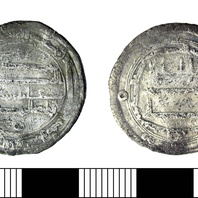
Viking Objects
Silver Dirham (DENO-07CCA4)
A complete silver dirham of Madinat al-Salam (Baghdad) reign of al-Mahdi Billah, 163 AH (780 AD). The dirham was a unit of weight used across North Africa, the Middle East, and Persia, with varying values which also referred to the type of coins used in the Middle East during the Viking Age. These coins were extremely prized possessions not only for their silver value but as a way of displaying one’s wealth and vast trade connections. Millions of Arabic dirhams would have been imported throughout the Viking world and are mostly found in hoards.
Read More
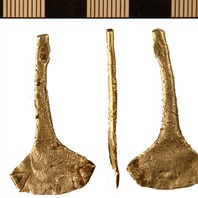
Viking Objects
Probable Thor’s Hammer Pendant (NLM-1A6811)
These may have been worn to show devotion to the god Thor, or to secure the god’s protection, although there is little evidence to support this interpretation. Pendants like this have been found made of lead, copper alloy, silver and gold, as well as other materials, showing that many different strata of society could have worn them. For more information on Scandinavian jewellery in England check out our blog: Brooches, Pendants and Pins: Scandinavian Dress Accessories in England.
Read More

Viking Objects
Samanid Silver Dirham (NCL-544D22)
A silver Samanid dirham of al-Shash dated possibly to 912 AD. The dirham was a unit of weight used across North Africa, the Middle East, and Persia, with varying values which also referred to the type of coins used in the Middle East during the Viking Age. These coins were extremely prized possessions not only for their silver value but as a way of displaying one’s wealth and vast trade connections. Millions of Arabic Dirhams would have been imported throughout the Viking world and are mostly found in hoards. Arabic dirhams demonstrate contact between the Viking diaspora and the Arabic world. Arabic coins are especially useful for dating sites, because they carry the date when they were minted. This permits precise dating where the part of the coin with the date survives, whereas European coins can only be dated to the reign of the ruler depicted on them. In western descriptions of these coins, the Arabic dates found on the coins are usually listed in square brackets, as above, and the European equivalent is listed after it.
Read More
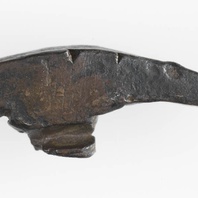
Viking Objects
Silver Thor’s Hammer Pendant (CM_1841_2008)
This is a high quality hammer-head section of a silver Thor’s hammer pendant. These may have been worn to show devotion to the god Thor, or to secure the god’s protection, although there is little evidence to support this interpretation. Pendants like this have been found made of lead, copper alloy, silver and gold, showing that many different strata of society could have worn them. For more information on Scandinavian jewellery in England check out our blog: Brooches, Pendants and Pins: Scandinavian Dress Accessories in England.
Read More
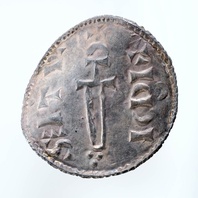
Viking Objects
Sihtric Caoch Silver Penny (CM.863-2002)
A sword and cross type silver penny of Sihtric Caoch (Sihtric Cáech) minted for the Viking kingdom of Northumbria. Sihtric Caoch was the Scandinavian ruler of Dublin from 917-920 CE and subsequently the ruler of Northumbria from 921-927 CE. It is not certain why he left Ireland. The Irish annals state that it was ‘through the grace of God’ and do not elaborate on the politics behind his departure. After the establishment of the Danelaw, some Viking leaders decided to mint their own coins to solidify their legitimacy in the eyes of the local populace. This created a hybrid economy where some members of the Danelaw used bullion and others used coins. This coin was part of a hoard of twelve coins found at Thurcaston between 1992 and 2000. The coins are Anglo-Saxon, Arabic and Viking issues, and show the diverse and wide-ranging contacts between societies at this time. The hoard was probably deposited c.923-925 CE, approximately five years after Leicester had been retaken by Mercia (c.918 CE). They indicate that a bullion economy was still operating in the Danelaw as late as the 920s. This suggests that the reconquest did not manage to institute Anglo-Saxon practices such as a monetary economy immediately.
Read More
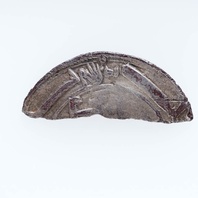
Item
Abbasid Silver Dirham Fragment (CM_1770_2008)
This fragment of a silver dirham was minted for the Abbasid ruler at Madinat al-Salam, [180-183] 796-799 CE . The dirham was a unit of weight used across North Africa, the Middle East, and Persia, with varying values which also referred to the type of coins used in the Middle East during the Viking Age. These coins were extremely prized possessions not only for their silver value but as a way of displaying one’s wealth and vast trade connections. Millions of Arabic Dirhams would have been imported throughout the Viking world and are mostly found in hoards. Arabic dirhams like this one from Torksey demonstrate contact between the Viking diaspora and the Arabic world. Arabic coins are especially useful for dating sites, because they carry the date when they were minted. This permits precise dating where the part of the coin with the date survives, whereas European coins can only be dated to the reign of the ruler depicted on them. In western descriptions of these coins, the Arabic dates found on the coins are usually listed in square brackets, as above, and the European equivalent is listed after it. This coin is a product of the Abbasid Caliphate which was ruled from its capital in Baghdad. The Abbasid Caliphate was at its greatest extent c.850 CE, occupying lands from Morocco in the west to Afghanistan in the east.
Read More
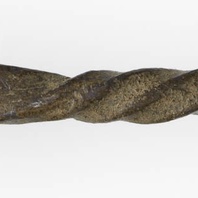
Viking Objects
Silver Ear Scoop Fragment (CM.1850-2008)
A fragment of a silver ear spoon or ear scoop with a body made from a spiral-twisted bar. Toilet articles like this were an important part of personal hygiene in the Viking Age. They were used to clean ear wax out of the ear and could be highly decorated to show off the user’s status.
Read More
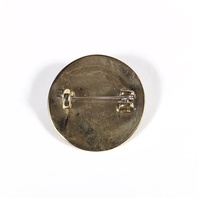
Viking Objects
Reproduction Silver Terslev Brooch
Terslev style, where Scandinavian ring-chain patterns are the main decorative component, is a subcategory of the Borre style and takes its name from the silver hoard discovered in Terslev, Denmark. The decoration comprises a series of ring-knots related to the Borre ring-chain. The Terslev style occurs mainly on brooches and pendants, including both high-quality gold and silver jewellery as well as lower-end base metal items. The cast-base metal jewellery, such as those made of copper alloy, were intended to imitate the higher-end gold and silver jewellery, and often employed techniques such as gilding to achieve this. The Terslev designs that occur in England extend the repertoire by introducing new Scandinavian motifs hitherto unrecorded in Scandinavia. For more information on Scandinavian jewellery in England check out our blog: Brooches, Pendants and Pins: Scandinavian Dress Accessories in England.
Read More
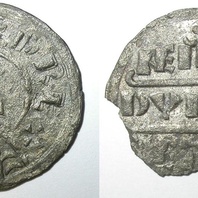
Viking Objects
Coin of Alfred the Great (1989-58/3381)
This silver penny from the mass grave at Repton was minted by a moneyer called Dudwine in Canterbury for Alfred the Great. Alfred was King of Wessex from 871 to 899 and spent most of his reign fighting off Viking invasions. He won a decisive victory at the Battle of Edington in 878 which resulted in a peace with the Vikings and the creation of the Danelaw. Minting coins was a way of controlling the means of exchange within a kingdom and which created a more easily administered standardized system of trade. Moreover, the coins themselves were often used as propaganda, portaying symbols and statements that gave off a desired message. The Vikings later used the minting of coins to legitimize their own rule.
Read More
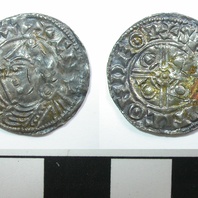
Viking Objects
Silver Penny (1960/459-2)
This silver penny was minted in Derby for King Cnut the Great, the Danish king who reigned over England from 1016-1035. It is not known precisely where it was found. Minting coins was a way of controlling the means of exchange within a kingdom and which created a more easily administered standardized system of trade. Moreover, the coins themselves were often used as propaganda, portaying symbols and statements that gave off a desired message. The Vikings later used the minting of coins to legitimize their own rule.
Read More
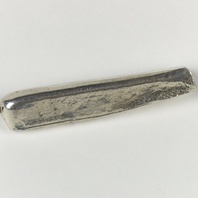
Viking Objects
Reproduction Silver Ingot
A white metal reproduction of a Viking Age silver ingot. Silver goods and coins might be melted down into ingots for ease of carrying.
